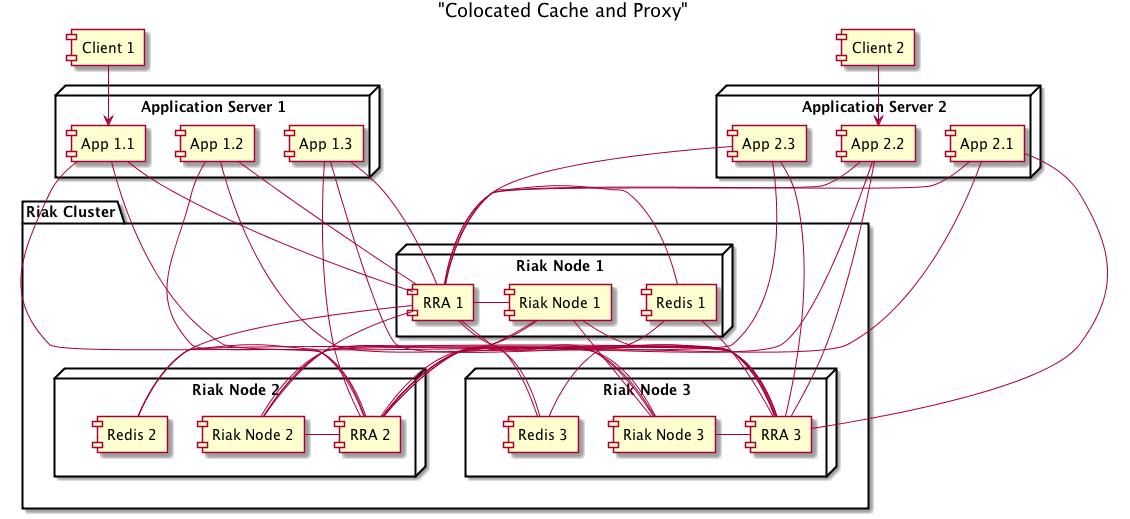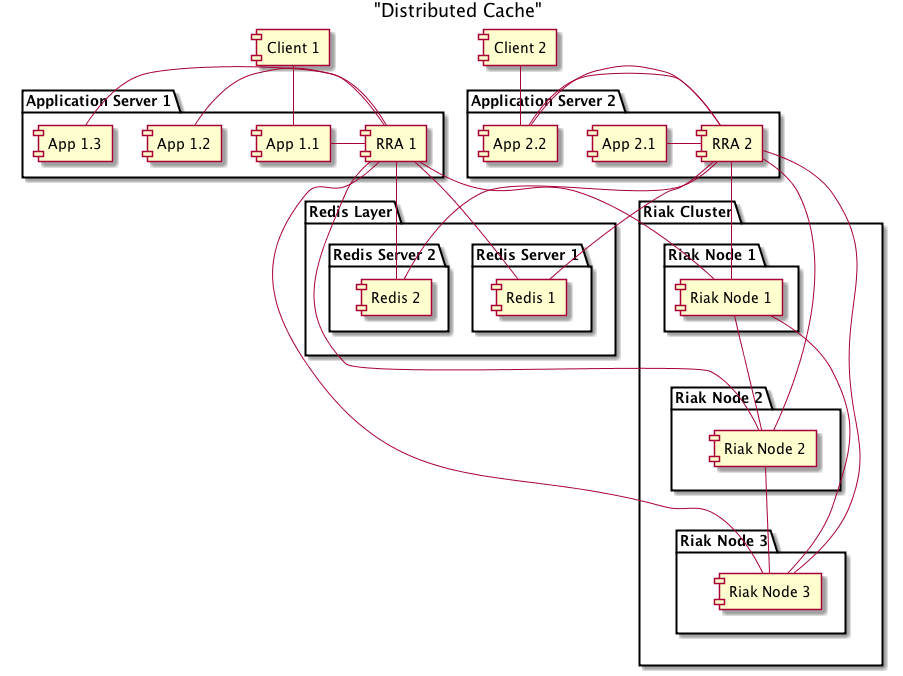Riak Redis Add-on Deployment Models
Deployment Models
Local Cache Deployment
In a local cache deployment, the RRA and Redis are deployed to the application server.

Connections:
- RRA: The connections between Application Service instances to RRA Service instance are local.
- Redis: The connection between the RRA Service instance and Redis Service instance is local.
- Riak: The connections between Application Servers to Riak Nodes is distributed and bounded to equal the number of Riak nodes multiplied by the number of Application Servers since they are aggregated at the RRA Service instance.
Advantages:
- Cache hits are extremely fast
Disadvantages:
- Cache writes on one application server are not observed on other application servers, so cache hit rates are likely lower unless some form of consistent routing to the application server exists within the solution.
- Redis competing for RAM with the application service may be problematic
Colocated Cache Deployment
In a colocated cache deployment, the RRA may be deployed either to the application server (suggested) or to the Riak servers and Redis is deployed to the Riak servers.
In the case of deploying the RRA to the application servers, the RRA features of reducing connections from the relatively high number of application service instances to the fewer Redis (cache) and Riak (persistent) data service instances allows for the greatest scale at the expense of the deployment cost of pushing a service and its configuration.
In the case of deploying the RRA to the colocated Redis and Riak data servers, the maximum scale for the solution is contrained by the number of network connections from the application services while deployment costs remain a matter of pushing a service and its configuration. In either case, deployment should be automated, so are not multiplied by the number of servers.

Connections:
- RRA: The connections between Application Service instances to RRA Service instance are distributed and bounded to equal the number of Riak nodes multiplied by the number of Application Service instances.
- Redis: The connection between the RRA Service instance and Redis Service instance is local.
- Riak: The connections between RRA to Riak Nodes is distributed and bounded to equal the number of Riak nodes squared.
Advantages:
- Increases the cache hit rate as a cache write from one application server will lead to a cache hit by all other application servers.
Disadvantages:
- Typically increased distance between the application service and Redis and Riak services, so slightly increased latency compared to local.
- Redis competing for RAM with Riak will likely be problematic. Redis should
be configured to ensure
maxmemoryandmaxmemory-policyconstrain Redis to ensure Riak is allotted sufficient RAM to serve the more important persistent data storage and retrieval services. See http://redis.io/topics/config - This model may seem to provide data locality, but in the case of faults in either Redis or Riak services, the fault tolerance mechanisms of RRA and Riak will not match exactly as communicating the necessary information to support such a lock-step fault tolerance would lead to greater mean latencies and Riak provides superior 99th percentile latency performance in the face of faults.
Distributed Cache Deployment
In a distributed cache deployment, the RRA is deployed to the application server and Redis is deployed to standalone servers, separate from Riak cluster nodes.

Connections:
- RRA: The connections between Application Service instances to RRA Service instance are local.
- Redis: The connection between the RRA Service instance and Redis Service instance are distributed and bounded to equal the number of Application Servers multipled by the number of Redis Servers.
- Riak: The connections between RRA to Riak Nodes is distributed and bounded to equal the number of Riak nodes multiplied by the number of Application Servers since they are aggregated at the RRA Service instance.
Advantages:
- Increases the cache hit rate as a cache write from one application server will lead to a cache hit by all other application servers.
- Keeps RRA near the application, reducing network connections.
- Moves Redis to distinct servers, allowing the cache more RAM and not constraining the RAM of either application or persistent data services.
Disadvantages:
- Typically increased distance between the application service and Redis and Riak services, so increased latency compared to local.
Recommendation
The relative advantages and disadvantages of the Distributed Cache Deployment, most notably the increased cache hit rate and reduced connection overhead, should make it the standout choice for applications requiring the scale and operational simplicity of Riak. For this reason, we recommend the Distributed Cache Deployment.
